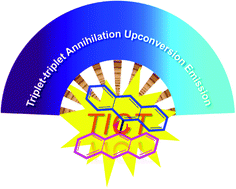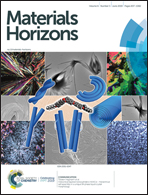Color-tunable upconversion emission from a twisted intramolecular charge-transfer state of anthracene dimers via triplet–triplet annihilation†
Abstract
Two anthracene dimers, 9,9′-BiAn and 2,9-BiAn, linked symmetrically or asymmetrically with a single bond were used as emitters in triplet–triplet annihilation upconversion (TTA-UC) for the first time. Upon photoexcitation, the localized excited states (LE) formed first and then twisted intramolecular charge-transfer (TICT) states were generated from these LE states in these two dimers. The generation of the TICT state in the symmetrical dimer, 9,9′-BiAn, is faster than that in the asymmetrical one, 2,9-BiAn. The TICT states of these two dimers are highly emissive, so they were tested as emitters in the TTA-UC process. The UC quantum yields could exceed 13% with PtOEP as a sensitizer. Notably, the color of the UC emission can be tuned from purple to cyan as the solvent polarity increases. This is the first example of color-tunable TTA-UC emission and also the first time that TICT molecules have been used as emitters in the TTA-UC process. As the interaction between the anthracene subunits is designable, this provides an opportunity to tune the emission properties of TTA-UC for different purposes of application without varying the excitation wavelength.



 Please wait while we load your content...
Please wait while we load your content...